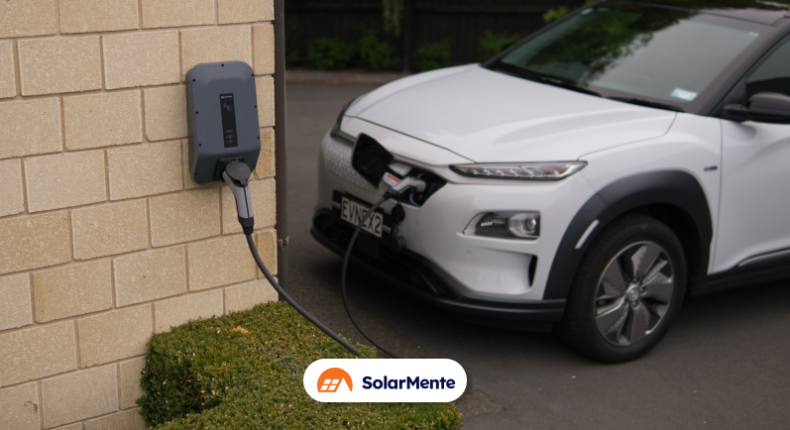The evolution of electric cars has made it possible to reduce the exorbitant prices of the market and become the new sustainable transport to reduce pollution.
And it represents a significant saving compared to the huge outlay we make when refuelling our vehicles nowadays.
It is true that this is still a growing sector and there is a lack of public charging points for electric cars, but there is now the possibility of installing electric car chargers in your own home.
You get convenience, savings and care for the environment at the same time – hard to refuse!
However, we understand that there may still be some doubts about this new method. That’s why today we want to talk to you about:
- What an electric car charger is and how it works.
- Types of chargers on the market.
- Charging modes for electric cars.
- Power requirements.
- Benefits you can get.
- Grants and subsidies.
How does an electric car charger work? .
Electric car chargers are devices used to charge vehicles that are powered by electricity and not by fossil fuels such as petrol or diesel.
Moreover, such elements are also used for plug-in hybrid cars.
Where can they be found?
In public service stations, shop car parks, shopping centres and even in large cities, but recent advances in technology have made it possible to install these devices in your home, next to your car. So we are talking about installing them in your private garage.
And how do they actually work?
It’s very simple. Once you have the installation in your home, the next step is to connect the car’s cable to the socket. It’s ready to go!
Depending on the chosen battery, the car will select the appropriate charging power for safety.
One thing you shouldn’t forget: it’s true that the installation of electric car chargers is not complex, but we always recommend that you go to a specialist who specialises in this area. You don’t want to be surprised.
Types of electric car chargers.
Well, we already know how these chargers work, but are there various models? How many alternatives are there? Does it make a difference to choose one or the other depending on my electric vehicle?
Yes, it is important to choose the right type of electric charger for your car. Having all the information at your fingertips will allow you to make the right decision.
Here is a list of the current models on the market:
- Schuko plug or conventional household socket
- Connector Type 1
- Connector Type 2
- Connector Type 3
- CHAdeMO connector
- CCS or combined single connector
Schuko plugSchuko plug.
This connector is also known as a domestic plug for a simple reason: the resemblance to a conventional plug is inescapable. It would be like charging an electric car in a normal socket.
In Europe, this connector is common and is used for most electrical appliances, but also for electric bicycles, motorbikes and scooters.
In reality, the Schuko plug is not the best plug for use in public spaces. The reason? The charging time: It’s quite slow and can take too long.
But it also has a positive side: it is compatible with all types of electric vehicles and can be plugged in anywhere. Even so, we still think it is not the most suitable model. Think and value your time.
Type 1 Connector
The Type 1 connector is also known as the Yazaki or Japanese connector. It is most commonly used in Asia and was the first device created for charging electric cars.
This device is single-phase and supports two levels of charging in alternating current.
Type 2 Connector
The electric car charger type 2 is known in the market under the name Mennekes. This is because it was the German brand that manufactured this device for the first time.
Moreover, it is the most widely used model in Spain and the rest of Europe and allows a wide power range for use in both single-phase and three-phase installations.
Brands such as Renault, Tesla, BMV or Nissan use this type of electric charger.
CHAdeMO connector
This connector is less known and less used in Europe, but it has a notable presence in Japan.
And there is a reason for this. The particular name of this connector comes from a Japanese association that includes the most important car companies in that territory.
But the advantage that we must highlight is its versatility. It is used for three-phase installations that use direct current with high speed and, what is better, the car can become a provider of clean electrical energy.
Some brands such as Kia, Peugeot and Nissan use this type of car charger, but be aware that they are not common in Europe and an adapter is required if you want to take full advantage of them.
CCS connector or single combined connector
The CCS or single combined connector differs in a relevant point with respect to the rest of the models analysed.
It allows charging your electric car with both alternating and direct current.
However, the most impressive feature is thecharging speed. At full power you can charge your vehicle, just like when you refuel your car with fuel.
Who is betting on this model? Brands such as SEAT, Audi and Tesla.
How many charging modes are there for electric cars? .
Charging modes may not be the most well-known part, but it is the part that communicates with the vehicle and is critical to safety.
So, how many chargers can we find? There are 4 current modes. Let’s see what uses each of them has.
We start with the mode 1. The current travels directly from the vehicle’s socket with no control unit between the two elements. Charging is slow and uses alternating current.
It is a system that has stopped working due to the risk of overheating. Read more: The US has decided to ban it and withdraw it from the market.
What’s next? The mode 2. This model is used for electric and hybrid cars. Yes it has a charge control unit that stops the supply in case of possible accidents such as overvoltage or different current levels among others.
We continue with the mode 3, known among the population for being the most commonly used in homes. It is most commonly installed on the wall near the vehicle for greater control of the load. That’s right, it’s not only valid for electric cars, but you can also use it if you have a plug-in hybrid.
Finally, the mode 4 does not work for home use, but is often found at public charging points. Since the cable is integrated into the charging point, you only need to connect it to your car. However, this mode only allows electric cars.
Available charging powers
To finish with the classification of chargers, it is necessary to consider their power. Theoretically, the more power the car has, the faster the charging will be.
But of course, there is an important point to clarify here. The maximum charging capacity of a car has two limitations:
- The power of the charger,
- And the power contracted at home.
Therefore, before making any decision you should consider the maximum power your car can take and check the power you have installed for your home. You will have to add up the power required for that charging point and then check whether it is necessary to increase the contracted power.
In short, we can differentiate chargers with a power of up to 3.7 kW, passing through 7.4 and 11 kW up to 22 kW.
High power ratings of 11-22 kW are more common for high-end cars with a large capacity. Examples? Brands like Tesla or Porsche.
Don’t forget that the way you use your car is also important. Your vehicle may allow a high power charger, but if you are going to use it exclusively for short journeys, you may not be interested in having a higher power rating.
Advantages of installing an electric car charger in your home
Just as installing solar panels on your home allows you to be more independent from the electricity company, electric car chargers work in the same way with combustion.
Considering the high fuel prices and the pollution they generate to the environment, the advantages of installing a charger in your home are different:
- It does not emit polluting gases into the atmosphere.
- Independence from price rises caused by inflation.
- Cheaper than charging in public areas.
- You don’t have to move your car to charge it.
And there’s more. This economic saving can be made even greater thanks to the installation of batteries for solar panels. You charge the car with the energy stored in the device and that’s it!
If you charge it during daylight hours, the cost can be fully reduced. However, charging at night is still much more cost-effective and can save more than 70% of the surplus energy fed into the grid.
Aid and subsidies for electric vehicles
You want to go for an electric car, but your budget is a bit tight and you need a helping hand.
Well, the government wanted to incentivise the purchase of electric vehicles as well as the acquisition of electric car chargers in Spain with the Plan Moves III.
This plan, in force since 2022, aims tosubsidise charging points by up to 70% whether you have a private home or live in a community of neighbours. This percentage of aid can be increased to 80% in small towns with less than 5,000 inhabitants.
What is our proposal for charging your electric car? .
At SolarMente, we don’t just install solar panels in your home. We can install electric car chargers to have a charging point in your private garage.
We work with various types of chargers. These are the three models you can choose from:
- Wallbox Pulsar Plus
- Stellar
- Policharger NW-T2
Wallbox Pulsar Plus
El cargador para coches eléctricos Wallbox Pulsar Plus es compatible con vehículos eléctricos e híbridos enchufables.
Es compacto, práctico y cuenta con conexión WiFi y Bluetooth para controlarlo desde la App MyWallbox con toda la comodidad del mundo.
Se trata de un dispositivo intuitivo para controlar la carga y programar aspectos como el horario o la potencia.
Para finalizar, este tipo de cargador emplea un modo 3 de carga, permitiendo los siguientes niveles de potencia:
- 7,4 kW en monofásico
- 11kW y 22kW en trifásico
Cargador Stellar
Al igual que El Wallbox Pulsar Plus, el cargador Stellar tiene la gran ventaja de conectalo con Bluetooth y hacer cualquier acción desde la aplicación móvil.
Podrás programar la carga de tu coche en el horario más convenido y avisar de posibles incidencias del sistema.
Dispone de un conector tipo 2 con potencia de carga hasta 7,4 kW y cuenta con un sistema de balanceo de carga para mayor seguridad seguridad, evitando de esta manera sobrecargas eléctricas.
Y esto no acaba aquí. Cuenta con 4 años de garantía. Nada mal, ¿no crees?
Cargador Policharger NW-T2
El cargador Policharger NW-T2, al igual que los dos modelos anteriores señalados, dispone de conectores tipo 2.
Cuenta con las mismas potencias de carga que el Wallbox Pulsar Plus. Esto es, 7,4 kW si es monofásico y 11 o 22 kW si es trifásico.
What other aspects should we consider? We tell you about them:
Allows charging in mode 3.
- Incorporates automatic regulation to make the most of the power.
- Includes cable.
- It comes with a 3-year warranty.
Finally, please note that this device does not include a mobile app, but don’t worry about this. The operation is very simple and is done through the model’s screen.
Recharging systems in the future: what changes lie ahead?
Charging systems for electric cars still have a lot of room for experimentation.
The technology is still in continuous movement and other possibilities are being explored that will have a strong impact in the future.
Such is the case of the solar panels in your car. No, we have not gone mad. Brands like Tesla and Toyota are already testing photovoltaic cells on vehicles to charge them with solar power. Prototypes are being tested to see how many kilometres of range they could provide.
The possibility of using wireless charging via electromagnetic induction is also being toyed with. Goodbye cables, electrical panels and any other component that allows charging. Benefits? More security for you and less theft of these installations or charging points.
Conclusions on electric vehicle chargers
Sooner or later, you will only see electric cars in cities. Europe has made it clear that it wants to get rid of combustion cars by 2035.
It is clear that it is the future transport that will allow us to move from one place to another with the guarantee of not emitting polluting gases and avoiding large outlays on non-renewable energies.
Technology advances year after year to improve its autonomy and new charging options. Eventually we won’t see it as rare and we will eliminate petrol from our lives.
Frequently asked questions.
How many kilometres can an electric car do?
The range of electric cars and plug-in hybrids has increased greatly, with models now available with a range of more than 400 km, such as the Hyundai Kona, and models such as the Tesla Model S with a range of up to 600 km.
In addition to price, range is another of the main factors we consider before making the switch to an electric vehicle.
For this very reason, companies are working and investing significant amounts of money to improve their technology.
How long does it take to charge an electric car? .
The charging time for an electric car is calculated by dividing the kW to be charged by the power of the charging point. This will give you an approximate figure for the number of hours needed.
Let’s use an example to make it easier to see. Imagine you have a car with a power of 60 kW and the charging point is 3.7 kWh. To fully charge your electric car, you will need 16.5 hours.
As you can see, the charging time is influenced by the type of charger.













